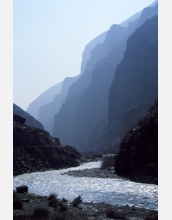News Release 05-059
Geologists Find New Active Fault in Nepal
Studies link climate with mountain building
April 20, 2005
This material is available primarily for archival purposes. Telephone numbers or other contact information may be out of date; please see current contact information at media contacts.
A research team has discovered a new active "thrust fault" at the base of the Himalaya Mountains in Nepal. The new fault likely accommodates some of the subterranean pressure caused by the continuing collision of the Indian subcontinent with Asia. The fault's discovery has led scientists to study how the speed of mountain-building in the Himalayas may be related to the counter-forces of erosion.
Results of the study will be published in the April 21 issue of the journal Nature.
This work "tackles one of the fundamental questions in this field," says Arjun Heimsath, an earth scientist at Dartmouth College in Hanover, N.H., and an author of the paper. "We are trying to determine whether climate is driving erosion, which may in turn impact tectonics, or whether tectonic forces drive erosion that subsequently influences climate. It’s sometimes called the classic chicken-or-egg problem in geomorphology." Along with Heimsath, authors of the paper are Cameron Wobus, Kelin Whipple, and Kip Hodges, all of the Massachusetts Institute of Technology (MIT).
According to the report, the results quantify a connection between erosion rates and tectonic forces, which might lead to a new understanding of how the growth of the Himalayas plays a role in global climate change. The new fault is found in an area where the structure of the landscape changes dramatically, and it’s in a region where the rainfall and erosion rates are among the highest in the world.
Heimsath and colleagues speculate there may be some sort of feedback mechanism between erosion and tectonic movement, which might help reduce the potential energy accumulated by the uplift of the Himalayas and the formation of the Tibetan plateau, a vast region where the mean elevation is over 16,000 feet.
"These results provide compelling evidence that we must study the Earth as a system of interacting processes," says Leonard Johnson, director of the National Science Foundation (NSF)'s continental dynamics program, which funded the research. "There may be a number of important feedback mechanisms among the components of the Earth system that we haven't discovered yet, and that are similar to this one between climate and tectonics."
Heimsath explains that as India continues to collide with Asia, the Himalayan Mountain Range grows a half-inch or more each year, and then the monsoons help bring about the erosion of the same mountains. The new active fault is at the base of the Great Himalaya in Central Nepal, about 60 miles from Kathmandu. There, the landscape changes from low relief and gently sloping hills to steep, high mountains. The researchers discovered that the erosion rates quadruple with the transition in topography.
"We used two different techniques of dating minerals in sediments to determine erosion rates spanning the past several thousand years as well as several million years," he says. There was corroboration over drastically different time scales of erosion rates from several watersheds, suggesting a close connection between erosion and tectonics.
"The incredible mass of this uplifted plateau is struggling for someplace to go, and it's possible that focused erosion processes, which remove material at a high rate along the base of the Himalaya, are enabling a reduction in this accumulated potential energy. It's a continent-sized physics problem," he says.
Co-authors of the paper are Cameron Wobus, Kelin Whipple and Kip Hodges, all of the Massachusetts Institute of Technology.
-NSF-
Media Contacts
Cheryl L. Dybas, NSF, (703) 292-7734, email: cdybas@nsf.gov
The U.S. National Science Foundation propels the nation forward by advancing fundamental research in all fields of science and engineering. NSF supports research and people by providing facilities, instruments and funding to support their ingenuity and sustain the U.S. as a global leader in research and innovation. With a fiscal year 2023 budget of $9.5 billion, NSF funds reach all 50 states through grants to nearly 2,000 colleges, universities and institutions. Each year, NSF receives more than 40,000 competitive proposals and makes about 11,000 new awards. Those awards include support for cooperative research with industry, Arctic and Antarctic research and operations, and U.S. participation in international scientific efforts.
Connect with us online
NSF website: nsf.gov
NSF News: nsf.gov/news
For News Media: nsf.gov/news/newsroom
Statistics: nsf.gov/statistics/
Awards database: nsf.gov/awardsearch/
Follow us on social
Twitter: twitter.com/NSF
Facebook: facebook.com/US.NSF
Instagram: instagram.com/nsfgov



